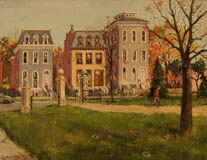
Lafayette Square Neighborhood, surrounding Lafayette Park, is St. Louis’s oldest historic district. It began as a 30 acre park that was platted in 1836, making it the first city park as well as the first park west of the Mississippi. It was named to honor the Marquis de Lafayette, the popular hero of the American Revolution, who visited St. Louis in 1825. For many years the area was considered too remote for residential development and it was used by Colonel Thornton Grimsley to train the “Home Guard.” Locally the park was known as “Grimsley’s Folley.”
The city made few improvements to the park until 1860 when the population of St. Louis had increased nine hundred percent over the previous 20 years. During the prosperous post-Civil War years, Lafayette Square became one of the most fashionable neighborhoods in St. Louis and the park became the city’s most popular recreation spot. Many well-known individuals built magnificent residences here, including future U.S. Supreme Court Justice Louis Brandeis, the noted jeweler D.C. Jaccard, prominent wine and grocery merchant David Nicholson, and three St. Louis mayors – John S. Thomas, James Britton and Henry W. Kiel.
Unfortunately, by the 1890s newer and increasingly popular neighborhoods were developing to the west of the city. On May 27, 1896, Lafayette Park was devastated by a tornado. Destruction to the grounds and surrounding homes was so extensive that many families decided to join the migration to the western areas of the city. While some restoration was done, the Lafayette neighborhood was left in a condition far from its original glory. By the 1920s it was a neglected, slightly disreputable part of the Near Southside. Many of the gorgeous homes had been divided into rooming houses and multiple rental units.
In the late 1960s a small group of individuals with a fondness for old homes entered the scene. They began extensive restoration and organized the Lafayette Square Restoration Committee. Subsequently, Lafayette Square has enjoyed a resurgence unparalleled in St Louis during an era of mass exodus to the suburbs. In 1972 the city acknowledged, by ordinance, Lafayette Square as its first historic district. In 1973, it was placed on the National Register of Historic Places by the U.S. Congress.
This neighborhood pride is clearly reflected in E. L. Karasek’s painting, created in the 1980s, that illustrates the relationship between the lush lawn of the park and the restored historic homes across the street. Karasek’s work was one of six created to illustrate scenes of St. Louis, and it is fitting that Lafayette Park, one of the city’s rescued treasures, was chosen as a representative site.